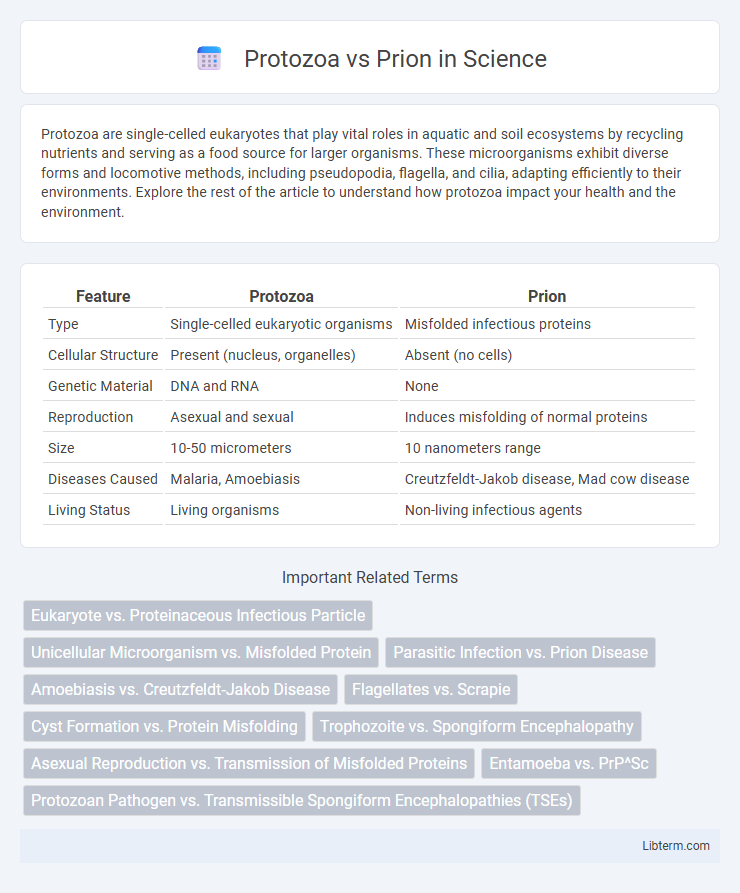Protozoa are single-celled eukaryotes that play vital roles in aquatic and soil ecosystems by recycling nutrients and serving as a food source for larger organisms. These microorganisms exhibit diverse forms and locomotive methods, including pseudopodia, flagella, and cilia, adapting efficiently to their environments. Explore the rest of the article to understand how protozoa impact your health and the environment.
Table of Comparison
| Feature | Protozoa | Prion |
|---|---|---|
| Type | Single-celled eukaryotic organisms | Misfolded infectious proteins |
| Cellular Structure | Present (nucleus, organelles) | Absent (no cells) |
| Genetic Material | DNA and RNA | None |
| Reproduction | Asexual and sexual | Induces misfolding of normal proteins |
| Size | 10-50 micrometers | 10 nanometers range |
| Diseases Caused | Malaria, Amoebiasis | Creutzfeldt-Jakob disease, Mad cow disease |
| Living Status | Living organisms | Non-living infectious agents |
Introduction to Protozoa and Prions
Protozoa are unicellular eukaryotic organisms found in diverse environments, known for their motility and heterotrophic nutrition. Prions are infectious agents composed solely of misfolded protein, causing neurodegenerative diseases such as Creutzfeldt-Jakob disease. Unlike protozoa, prions lack nucleic acids and cellular structures, making them unique infectious pathogens.
Defining Protozoa: Characteristics and Classification
Protozoa are single-celled eukaryotic organisms characterized by their ability to move independently using cilia, flagella, or pseudopodia, and they reproduce primarily through binary fission or multiple fission. Classified within the kingdom Protista, protozoa exhibit diverse forms ranging from amoebas and ciliates to flagellates, each adapted to various aquatic and terrestrial environments. Unlike prions, which are infectious misfolded proteins lacking cellular structure and genetic material, protozoa have complex cellular machinery capable of metabolism, growth, and asexual or sexual reproduction.
Understanding Prions: Structure and Function
Prions are infectious proteins that lack nucleic acids, distinguishing them from protozoa, which are single-celled eukaryotic organisms with complex cellular structures. The unique structure of prions involves a misfolded form of the normal prion protein (PrP), which induces abnormal folding in healthy proteins, leading to neurodegenerative diseases such as Creutzfeldt-Jakob disease and mad cow disease. Unlike protozoa, prions propagate by altering protein conformation rather than replication or reproduction, making their mechanism of infection fundamentally different and challenging for traditional pathogen-targeted treatments.
Major Differences Between Protozoa and Prions
Protozoa are unicellular eukaryotic organisms with complex cellular structures, including nuclei and organelles, while prions are misfolded proteins lacking any cellular components. Protozoa reproduce independently through processes such as binary fission or conjugation, whereas prions propagate by inducing abnormal folding of normal proteins without genetic material. Protozoa are classified as living organisms involved in various ecological roles, whereas prions are infectious agents causing neurodegenerative diseases like Creutzfeldt-Jakob disease.
Modes of Transmission: Protozoa vs Prions
Protozoa primarily transmit through contaminated water, food, or vectors such as mosquitoes, causing infections like malaria and amoebiasis. Prions spread mainly via ingestion of infected tissues, medical procedures involving contaminated instruments, or inherited genetic mutations, leading to neurodegenerative diseases like Creutzfeldt-Jakob disease. Unlike protozoa, prions lack nucleic acids and rely solely on protein misfolding, influencing their unique transmission pathways.
Diseases Caused by Protozoa
Protozoa are single-celled eukaryotic organisms responsible for diseases such as malaria, caused by Plasmodium species, amoebiasis from Entamoeba histolytica, and sleeping sickness due to Trypanosoma brucei. These parasites invade host cells, leading to severe clinical symptoms including fever, diarrhea, and neurological disorders. Unlike prions, which are infectious proteins linked to neurodegenerative disorders like Creutzfeldt-Jakob disease, protozoa are cellular pathogens causing a range of parasitic infections.
Human Disorders Linked to Prions
Prions are infectious proteins responsible for a group of fatal neurodegenerative disorders in humans, including Creutzfeldt-Jakob disease (CJD), variant CJD, and Kuru. Unlike protozoa, which are single-celled organisms causing diseases such as malaria and amoebiasis, prions propagate by inducing misfolding of normal cellular proteins, leading to brain damage and rapid cognitive decline. Human prion diseases are characterized by spongiform changes in brain tissue, lack of immune response, and currently have no effective treatments.
Diagnosis and Detection Methods
Protozoa diagnosis relies on microscopic examination, antigen detection, and molecular techniques such as PCR for identifying specific parasitic DNA, often using stool, blood, or tissue samples. Prion diseases require detection of misfolded prion proteins through techniques like Western blot, immunohistochemistry, and Real-Time Quaking-Induced Conversion (RT-QuIC) assay in cerebrospinal fluid or brain tissue. Both protozoa and prions demand highly sensitive and specific methods, with molecular assays playing a crucial role in early and accurate detection.
Treatment and Prevention Strategies
Treatment of protozoan infections typically involves antiprotozoal drugs such as metronidazole or chloroquine, targeting specific species like Plasmodium or Giardia, whereas prion diseases lack effective treatments due to their unique protein misfolding pathology. Preventive measures for protozoa include vector control, safe water practices, and prophylactic medications in endemic regions, while prion disease prevention focuses on avoiding contaminated tissue exposure and strict sterilization protocols in medical settings. Understanding the biological differences between protozoa and prions is critical for developing appropriate therapeutic and preventive strategies.
Conclusion: Key Takeaways on Protozoa vs Prion
Protozoa are complex, single-celled eukaryotic organisms capable of reproduction and metabolism, whereas prions are misfolded proteins causing neurodegenerative diseases without genetic material or cellular structure. Understanding their fundamental differences aids in developing targeted treatments: antimicrobial strategies for protozoan infections and protein misfolding interventions for prion diseases. This distinction underscores the contrasting biological nature and pathogenic mechanisms critical for medical research and disease management.
Protozoa Infographic

 libterm.com
libterm.com